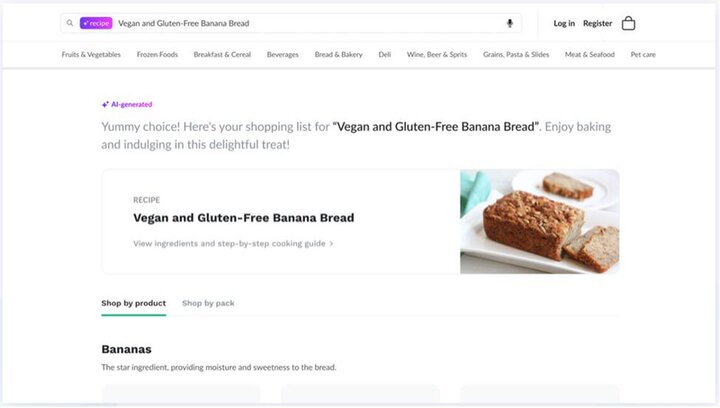

Cooking up Personalized Experiences in Grocery Ecommerce
When it comes to serving up personalized digital experiences, grocery has a leg up on many other retail sectors.
That’s because there are so many deep, rich and immediate opportunities to understand shoppers and their intent — even if they’re a first-time visitor.
Across other areas of ecommerce, the average cart/basket size is about four items per transaction (and frequently less). In grocery, it’s often 30. Plus, consumers tend to shop for groceries more frequently than they do other categories (apparel, electronics, furniture, etc.) – sometimes grocery-shopping multiple times per week.
This makes it much easier for grocers to learn about and know their shoppers. Every click, add-to-cart, and active time spent on site can shed light on shoppers’ preferences and be leveraged algorithmically.
For example, by following the user clickstream, does a given shopper tend to buy organic? Do they prefer bulk items? Lean toward items on sale? If the latter, when that shopper searches for “shredded cheddar,” you can prioritize the brand that’s “buy one, get one free” in search results: creating a better experience for the customer while increasing the likelihood of conversion.
Being able to glean such detailed insights in a single session is unique to grocery: In many other sectors, it takes far longer to amass such useful data.
What’s more, given this distinction, grocers are especially well-positioned to take advantage of advanced and emerging applications for AI-based personalization, and drive differentiated impact. Let’s look at two use cases:
Expected to capture one-fifth of US ad spend this year, retail media is a hot topic in ecommerce and increasingly important revenue stream for ecommerce grocers. Retail media involves using a retailer’s properties — such as their website or mobile app — to provide advertising opportunities for brands.
One such opportunity you may be familiar with is sponsored listings, which can appear in search results, browse experiences, recommendations and so on. You’ve probably seen these on Amazon: You search for an item, and relevant products (denoted “sponsored”) appear atop the search results.
This is valuable real estate for digital advertising… but consumers and grocers alike get shortchanged when sponsored listings are generic and impersonal. If listings are only technically relevant (e.g., a shopper searches for “soap,” and soaps get returned — but that person really wants hand soap, not bar soap, and not the brands shown), then everyone loses: the shopper, the grocer, and the advertiser shelling out for the sponsored listing.
However, by baking personalization into what’s displayed, there’s great opportunity for grocers to improve sponsored listing performance — making them more attractive to shoppers. With all the shopper data at their disposal, grocery retailers can be more selective about which ads are shown, to whom and where, so they can better monetize their digital spaces.
Grocers are especially well-positioned to take advantage of AI-based personalization, creating better experiences for customers while increasing the likelihood of conversion.

Improving retail media performance
Case in point: Let’s say a shopper already has organic cauliflower, organic beef and organic eggs in their online cart. When that shopper searches for “milk,” you’ll know they’re a great candidate for a sponsored listing featuring organic milk.
Plus, by incorporating sponsored listings into your search results — an interface your shoppers are already familiar with — and tailoring listings on a per-shopper level, you’re taking an approach that won’t disrupt the customer experience or hurt organic traffic. In fact, it’s likely to enhance the experience for shoppers. In addition, integrating sponsored listings with your search engine also ensures ads get seen and not trapped by ad blockers.
The result is a win-win-win: Shoppers get a more helpful, tailored experience; advertisers benefit from more efficient ad spending (targeting the right audience, with a higher purchasing intent); and grocers increase revenue from shoppers and advertising partners alike.
This is already being borne out: A major US grocer piloting this approach is projecting a seven-figure lift in ad revenue over the course of a year, with no loss in organic revenue either.
In addition and in general, most grocers see a 1-3% margin on product. On sponsored listings, businesses often enjoy a 70-90% margin.
Personalization plays a powerful role in another cutting-edge solution for grocery ecommerce: AI shopping assistants. These may sound like future innovations, but they’re in use today: Amazon and Walmart have their own proprietary solutions, and some software vendors offer white-labeled functionality too.
Here’s an example of how these assistants can work: When grocery shoppers have a query that would formerly befuddle search engines — e.g., “Help me fill my fridge with essentials” or “It’s my turn to bring snacks to my son’s soccer game. What are some popular, healthy ideas?” or “Birthday treats that accommodate peanut allergies” or “Give me a recipe for a seven-layer dip” (and so on!) — the generative AI-powered engines not only understand the questions but can provide responses/results that make sense.
In addition, tapping into real-time inventory, AI assistants generate suggestions that are in-stock at the shopper’s local store and personalized to the shopper at hand.
Take the seven-layer-dip recipe example — let’s say it calls for salsa, sour cream, refried beans etc. After dynamically generating the recipe, the AI assistant can also show ingredients likely to appeal to each shopper. For a shopper that tends to buy low-sodium foods, low-sodium refried beans can get displayed.
AI shopping assistants

A large US grocer using an AI assistant to support recipe generation — making it easy for shoppers to add all ingredients to cart — saw a nearly 4% increase in search conversions: a strategy that literally paid off.
AI assistants may be well on their way to being the wave of the future: A recent Deloitte survey showed nearly one-third of grocery executives (31%) think AI assistants have the greatest “killer application” potential, when it comes to generative AI use cases. Other data illustrates how such assistants alleviate shopper pain points: Roughly a quarter of US shoppers (23%) think “the ability to type full sentences into the search bar… and have it understand” would improve ecommerce search.
AI assistants enable shoppers to search for recipes — automatically generating recipe content with in-stock, personalized ingredients.
Often in grocery, it’s an all-or-nothing proposition: If a single ingredient is missing from a checkout, then the entire cart (with all the staples of eggs, milk, cereal, etc.) gets abandoned and purchased somewhere else. So, it’s essential to make it easy for online shoppers to find what they like, want and need.
To that end, across ecommerce, there’s great potential to apply personalization to enhance customer experiences… but in grocery, it may take the cake.
If you’re looking to explore new AI-based innovations — using personalization in sponsored listings, AI assistants, etc. — the time is ripe. That’s because when it comes to cooking up engaging, revenue-generating experiences, knowing your customers is the prime ingredient for success.
Getting personal




